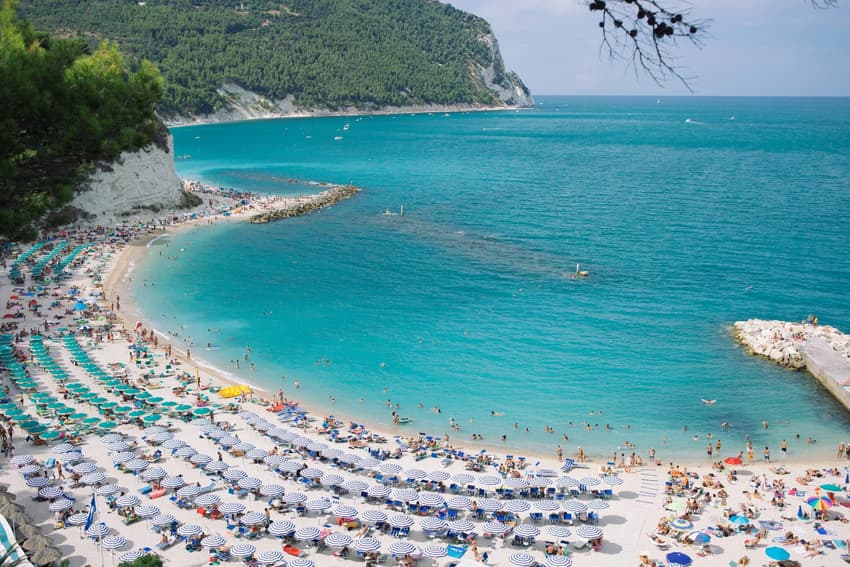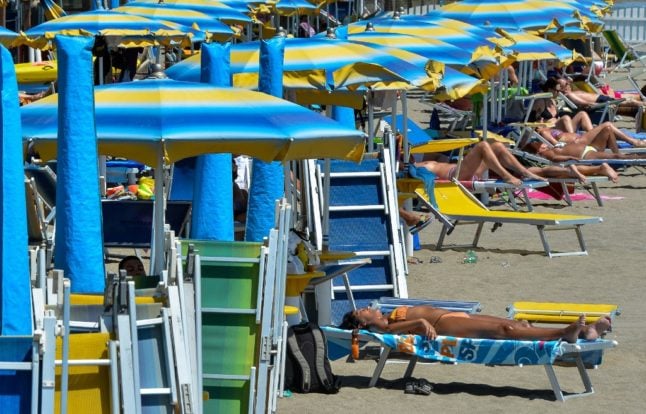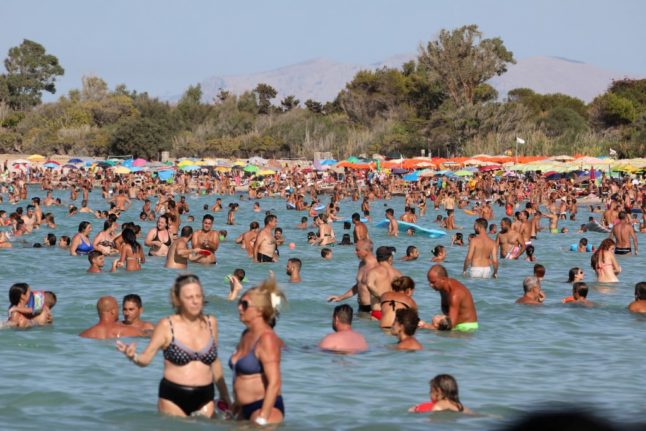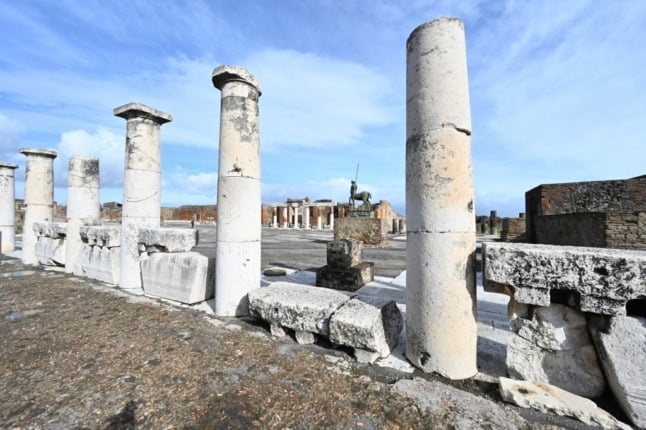OPINION: Is Italy’s west or east coast the best place for a holiday?

Choosing which coast to visit in Italy can be a tough call, particularly if you’re planning to spend most of the time sunbathing and swimming. Reporter Silvia Marchetti shares her insights on the pros and cons of both.
The Tyrrhenian west coast and the Adriatic east one are very different, and each come with their pros and cons.
In my view the Tyrrhenian side of the boot wins, because even though it tends to be more crowded due to the many art cities located along it, its beaches have fewer facilities for families and the shores are more ragged, with rocks and cliffs ideal for solo and adventurous young people.
The Amalfi coast’s picturesque fishermen villages, or Liguria’s Cinque Terre, feature tiny pebble stone bays cut between high cliffs with little space for sun umbrellas and beds.
The Adriatic, on the other hand, is a mass destination for foreign sunbathers, very popular especially among German and Russian tourists. The east coast has Italy’s widest and flattest sandy beaches, which make it an ideal spot for families - but also very crowded.
READ ALSO: Private lidos take up more than 40 percent of Italian beaches: report
The Adriatic shore is one long line of adjacent beach facilities that run for kilometres from the northern Friuli-Venezia Giulia region down south to Puglia.
Beaches in the seaside towns of Rimini and Riccione, located along the chaotic Riviera Romagnola renowned also for its wild nightlife, feature up to 50 rows of sun beds and umbrellas in summer.

More sunbeds than sand... Some parts of Italy are heavily built-up with an abundance of services. (Photo by ANDREAS SOLARO / AFP)
Beach facilities there resemble open-air condominiums where there are children's playgrounds, restaurants, sleeping areas, dance floors and changing rooms for clients.
One good thing, though, is the constant presence of bay watchers and lifeguards at each facility, who are present throughout all eastern coastal regions and very helpful if you don’t constantly want to look after the kids. Beach resorts often come with big seaside multi-floor hotel buildings that look like city offices.
To escape the crowds on the Adriatic coast you need to pick niche, rocky spots with very few beaches such as the Conero Hill in the Marche region and the Gargano promontory in Puglia.
While the Adriatic coast’s wide and easily accessible beaches are great for children and older people, the sea is not always clear and there are just a few top scuba diving and snorkelling spots, such as the beautiful Tremiti islands.
The Tyrrhenian sea, which is deeper than the Adriatic, is packed with diving sites: Ustica island in Sicily and Ventotene isle in Latium are Italy’s top diving meccas brimming with barracudas and giant groupers.
Tyrrhenian waters are cleaner too: in 2021, its shores won more bandiera blu (Blue flag) awards for high water quality standards than Adriatic beaches.
READ ALSO: Where to find even more of Italy’s best beaches
There are also more protected marine reserves along the west coast, which guarantees a pristine environment, and more free beaches without facilities and lifeguards. While this ‘wild’ aspect may be attractive to many, it could make some beaches not suitable for families with small kids.

Family friendly beaches tend to draw in more crowds. (Photo by ludovic MARIN / AFP)
On the other hand, given its relatively shallow waters, the Adriatic is blessed with reasonable stocks of fish, so if you long for fishing expeditions it’s the perfect destination.
However the real plus point of the east coast is its strategic location facing other Mediterranean countries and allowing tourists, particularly from the US, to expand their holidays and exploit Italy as the door to the 'Old Continent'. From the ports of Bari and Ancona, ferry boats depart to Greece, Slovenia, Croatia and Albania.
The winning asset of the Tyrrhenian, other than its translucent waters and baby powder beaches, is the huge artistic heritage it offers visitors. The west coast boasts the top must-see Italian cities usually picked by global tourists (Rome, Naples, Florence) which all lie, or are close to the sea - except for Venice (the gem of the Adriatic).
READ ALSO:
- Ten must-see places within reach of Rome
- These are the best beaches within easy reach of Rome
- 16 surprising facts about Venice to mark 16 centuries of the lagoon city
The cultural appeal of the west side makes the central national highway, the A1 - otherwise known as Autostrada del Sole - a very trafficky infrastructure.
There are also mesmerising fishermen villages with a mythological vibe along the Tyrrhenian coast, such as Gaeta and Sperlonga, where it is said Odysseus, the legendary Greek king, landed during his wanderings.
Plus, most of Italy’s UNESCO heritage-listed sites are located along or near the west shore. For instance, the archaeological excavations of Pompeii are among the top tourist hotspots in Italy.
READ ALSO: Life in Italy in 2022: 10 things to add to your bucket list
Generally speaking, the appeal of popular places along the west coast inevitably translates into more expensive hotels and travelling costs but it depends on the specific location.

A photo shows a general view of the archaeological site of Pompeii, near Naples. (Photo by Andreas SOLARO / AFP)
The major west coast lure for sea dogs, sailing amateurs and fans of the tan is that nearly all Italian islands are located in the Tyrrhenian sea and reachable from the mainland.
The two island regions of Sardinia and Sicily are accessible by ferry boat from Naples and Civitavecchia, while the Tuscan archipelago, the Pontine islands and Sicily’s dozens of ‘satellites’ such as the Aeolian, Egadi and Pelagie isles are tropical paradises just a stone’s throw from the cultural highlights.
READ ALSO: Ten percent of the world’s best beaches are in Italy
Even though both coasts are stunning and are worth exploring, personally, I’d chose the Tyrrhenian over the Adriatic any day, and not just because I’m a Roman who lives in Rome.
It has a diversified offer of artistic sites and beaches, inlets and cliffs that allow you to savour the most of Italy in just a few days.
The last time I rented my beach home south of Rome to a French couple, I thought they’d laze all day under the sultry sun. Instead they drove across half of Italy in 14 day trips, visiting Florence, Naples, Sorrento and Calabria.
Comments
See Also
The Tyrrhenian west coast and the Adriatic east one are very different, and each come with their pros and cons.
In my view the Tyrrhenian side of the boot wins, because even though it tends to be more crowded due to the many art cities located along it, its beaches have fewer facilities for families and the shores are more ragged, with rocks and cliffs ideal for solo and adventurous young people.
The Amalfi coast’s picturesque fishermen villages, or Liguria’s Cinque Terre, feature tiny pebble stone bays cut between high cliffs with little space for sun umbrellas and beds.
The Adriatic, on the other hand, is a mass destination for foreign sunbathers, very popular especially among German and Russian tourists. The east coast has Italy’s widest and flattest sandy beaches, which make it an ideal spot for families - but also very crowded.
READ ALSO: Private lidos take up more than 40 percent of Italian beaches: report
The Adriatic shore is one long line of adjacent beach facilities that run for kilometres from the northern Friuli-Venezia Giulia region down south to Puglia.
Beaches in the seaside towns of Rimini and Riccione, located along the chaotic Riviera Romagnola renowned also for its wild nightlife, feature up to 50 rows of sun beds and umbrellas in summer.

Beach facilities there resemble open-air condominiums where there are children's playgrounds, restaurants, sleeping areas, dance floors and changing rooms for clients.
One good thing, though, is the constant presence of bay watchers and lifeguards at each facility, who are present throughout all eastern coastal regions and very helpful if you don’t constantly want to look after the kids. Beach resorts often come with big seaside multi-floor hotel buildings that look like city offices.
To escape the crowds on the Adriatic coast you need to pick niche, rocky spots with very few beaches such as the Conero Hill in the Marche region and the Gargano promontory in Puglia.
While the Adriatic coast’s wide and easily accessible beaches are great for children and older people, the sea is not always clear and there are just a few top scuba diving and snorkelling spots, such as the beautiful Tremiti islands.
The Tyrrhenian sea, which is deeper than the Adriatic, is packed with diving sites: Ustica island in Sicily and Ventotene isle in Latium are Italy’s top diving meccas brimming with barracudas and giant groupers.
Tyrrhenian waters are cleaner too: in 2021, its shores won more bandiera blu (Blue flag) awards for high water quality standards than Adriatic beaches.
READ ALSO: Where to find even more of Italy’s best beaches
There are also more protected marine reserves along the west coast, which guarantees a pristine environment, and more free beaches without facilities and lifeguards. While this ‘wild’ aspect may be attractive to many, it could make some beaches not suitable for families with small kids.

On the other hand, given its relatively shallow waters, the Adriatic is blessed with reasonable stocks of fish, so if you long for fishing expeditions it’s the perfect destination.
However the real plus point of the east coast is its strategic location facing other Mediterranean countries and allowing tourists, particularly from the US, to expand their holidays and exploit Italy as the door to the 'Old Continent'. From the ports of Bari and Ancona, ferry boats depart to Greece, Slovenia, Croatia and Albania.
The winning asset of the Tyrrhenian, other than its translucent waters and baby powder beaches, is the huge artistic heritage it offers visitors. The west coast boasts the top must-see Italian cities usually picked by global tourists (Rome, Naples, Florence) which all lie, or are close to the sea - except for Venice (the gem of the Adriatic).
READ ALSO:
- Ten must-see places within reach of Rome
- These are the best beaches within easy reach of Rome
- 16 surprising facts about Venice to mark 16 centuries of the lagoon city
The cultural appeal of the west side makes the central national highway, the A1 - otherwise known as Autostrada del Sole - a very trafficky infrastructure.
There are also mesmerising fishermen villages with a mythological vibe along the Tyrrhenian coast, such as Gaeta and Sperlonga, where it is said Odysseus, the legendary Greek king, landed during his wanderings.
Plus, most of Italy’s UNESCO heritage-listed sites are located along or near the west shore. For instance, the archaeological excavations of Pompeii are among the top tourist hotspots in Italy.
READ ALSO: Life in Italy in 2022: 10 things to add to your bucket list
Generally speaking, the appeal of popular places along the west coast inevitably translates into more expensive hotels and travelling costs but it depends on the specific location.

The major west coast lure for sea dogs, sailing amateurs and fans of the tan is that nearly all Italian islands are located in the Tyrrhenian sea and reachable from the mainland.
The two island regions of Sardinia and Sicily are accessible by ferry boat from Naples and Civitavecchia, while the Tuscan archipelago, the Pontine islands and Sicily’s dozens of ‘satellites’ such as the Aeolian, Egadi and Pelagie isles are tropical paradises just a stone’s throw from the cultural highlights.
READ ALSO: Ten percent of the world’s best beaches are in Italy
Even though both coasts are stunning and are worth exploring, personally, I’d chose the Tyrrhenian over the Adriatic any day, and not just because I’m a Roman who lives in Rome.
It has a diversified offer of artistic sites and beaches, inlets and cliffs that allow you to savour the most of Italy in just a few days.
The last time I rented my beach home south of Rome to a French couple, I thought they’d laze all day under the sultry sun. Instead they drove across half of Italy in 14 day trips, visiting Florence, Naples, Sorrento and Calabria.
Join the conversation in our comments section below. Share your own views and experience and if you have a question or suggestion for our journalists then email us at [email protected].
Please keep comments civil, constructive and on topic – and make sure to read our terms of use before getting involved.
Please log in here to leave a comment.